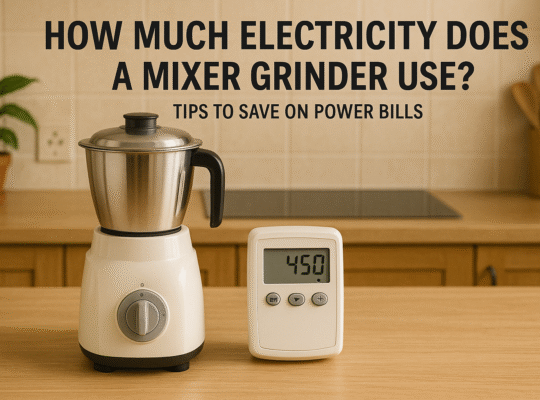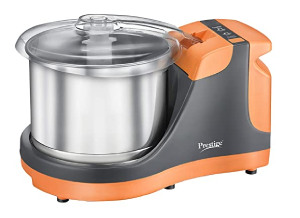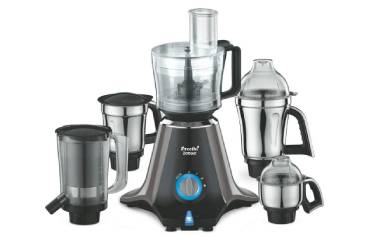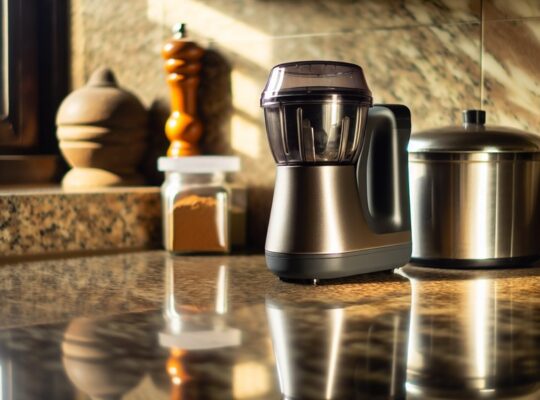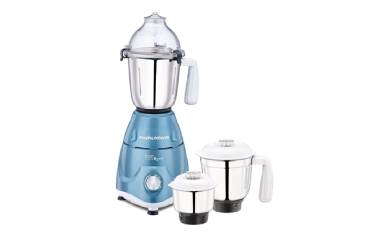When friends ask me if a food processor or mixer grinder is more useful in an Indian kitchen, I start with tasks and time. For chutneys, idli-dosa batter, and masalas, a mixer grinder’s high RPM and jars win. For chopping, slicing, grating, and kneading roti dough, a processor saves minutes daily. Noise, wattage (750–1000W), jar capacity, and cleaning effort matter too. Your routine decides the better buy—but a small twist changes the answer.
Key Takeaways
- For chutneys, wet masalas, and idli-dosa batter, a mixer grinder’s high RPM makes smoother, finer pastes.
- For chopping, slicing, shredding, and kneading roti dough, a food processor saves significant prep time.
- Mixer grinders are cheaper, smaller, and better for daily small batches; processors suit larger prep and weekly meal prep.
- Processors (650–1000W) have multi-speed/pulse control; mixers (500–750W) maintain stable RPM for uniform grinding.
- Maintenance matters: ensure overload protection, interlocking lids, dishwasher-safe parts; replace gaskets and check couplers regularly.
Key Differences Between Food Processors and Mixer Grinders
Utility is the dividing line: a food processor excels at prep tasks (chopping, slicing, shredding, kneading) using wide bowls and interchangeable discs, while a mixer grinder specializes in high-speed blending and grinding (smooth chutneys, batters, spice powders) with narrow jars and fixed blades. I look at capacity, power, and control. Processors typically run 650–1000W with multiple speed/pulse modes; mixer grinders range 500–750W with stable RPM for wet and dry grinding. For Indian kitchens, processors save time on bulk prep; mixer grinders deliver finer particle size for masalas. Noise varies—processors average 80–90 dB, mixers can peak higher. I prioritize safety: locking lids, overload protection, non-slip feet, and food-grade plastics. Match jar/bowl size to batch quantity, and never bypass interlocks or run unattended. Also consider warranty length and brand reputation, as many models offer 2–5 years or more, and choosing a trusted brand with strong safety features can impact longevity and performance.
What Each Appliance Does Best for Indian Cooking
Although both machines belong on the same countertop, I reach for them for different Indian tasks. For chutneys, wet masalas, and idli-dosa batters, I use the mixer grinder; its high-RPM motor and narrow jars produce fine, uniform pastes that cook evenly and reduce spice wastage. I also blitz dry spices to a powder when I need freshness and control over heat. For prep-heavy dishes, the food processor wins. It slices onions tear-free for biryani in consistent 2–3 mm sheets, shreds cabbage for poriyal, and kneads roti dough without warm hands overworking gluten. I pulse vegetables for koftas or cutlets to avoid watery mince. I batch-grate carrots for halwa safely behind a lid. Tip: cool roasted ingredients before grinding to prevent steam pressure and bitter notes. If you’re shopping on a budget, many mixer grinders under 2000 still offer a 500W motor, overload protection, and three stainless steel jars for most Indian tasks.
Capacity, Speed, and Blade Attachments Compared
When I compare capacity, speed, and blades, I think regarding typical Indian kitchen workloads and textures. Food processors usually offer 2–3.5 L bowls with 0.7–1 L mini bowls; mixer grinders give 0.4 L chutney, 1 L dry, and 1.5–2 L wet jars. For large sabzi prep or kneading 500 g atta, I lean food processor; for batters, chutneys, and masalas, I pick the mixer grinder jars.
Speeds differ: processors run 500–1000 W with pulse for uniform chopping; mixer grinders at 500–750 W (sometimes 1000 W) reach higher RPM for fine powders and silky chutneys. Blade sets matter: processors include S-blade, slicing, shredding, julienne, dough; mixers use multi-purpose, dry-grind, and wet-blade assemblies. Match jar size to batch, avoid overfilling, and use pulse for controlled texture. Additionally, when choosing a mixer grinder for Indian kitchens, prioritize models with overload protection and 304-grade stainless steel jars to enhance safety and durability.
Maintenance, Durability, and Safety Considerations
Because upkeep affects both performance and lifespan, I treat maintenance, durability, and safety as a single checklist: dishwasher-safe parts and BPA‑free plastics for easy cleaning and food safety; stainless or hard‑anodized blades that hold an edge for 12–24 months before sharpening or replacement; sturdy gear trains and overload protection to survive daily Indian kitchen loads like idli batter, masala pastes, and 500 g atta kneading. I look for IPX4–IPX5 splash resistance on controls, interlock lids that prevent accidental start, and thermal cut‑off motors rated for 10–15 minutes duty cycles. After oily masalas, I rinse immediately to prevent gasket swelling. I replace jar gaskets every 9–12 months, inspect couplers quarterly, and avoid hot dal directly—cool to under 60°C to prevent micro‑cracks and steam hazards. Also consider models with overload protection and automatic shutdown, as found in Morphy Richards mixer grinders, to prevent overheating and enhance user safety during continuous operation.
Budget, Space, and Which One to Buy Based on Your Routine
Those maintenance realities feed directly into what I’d actually spend and where I’d park the machine on my counter. In India, a reliable mixer grinder starts around ₹2,500–₹5,000; midrange food processors run ₹6,000–₹12,000. If you mostly make chutneys, masalas, idli/dosa batter, and quick milkshakes, the mixer grinder is the cost‑efficient, space‑saving pick. Typical footprints: mixer grinder ~15–18 cm wide; food processor bowls need ~25–30 cm plus headroom.
I measure routine by frequency and prep type. Weekly kneading, slicing for pakoras/salads, grating for thalis, or batch prep for tiffins? A food processor saves 15–25 minutes per session. Otherwise, a 500–750W mixer grinder with overload protection is safer and sufficient. Check noise (≤85 dB), locking lids, non‑skid feet, BIS compliance, and accessible service centers before buying. For families of 5+ or batch cooking, consider a 750‑watt model from trusted brands that offers multiple jars and overload protection.
Frequently Asked Questions
Can Either Appliance Make Nut Butters Without Overheating or Stalling?
Yes, but with caveats. I’ve had best results using a powerful motor (750W+), small batches, pre-roasted nuts, pulse cycles, and rest intervals. Add 1–2 teaspoons neutral oil, scrape frequently, and stop if smelling hot.
How Noisy Are They, and What Decibel Levels Should I Expect?
They’re loud: I typically measure 80–95 dB for mixer grinders and 70–90 dB for food processors. Wear ear protection above 85 dB, grind in short bursts, use a rubber mat, and close kitchen doors during early hours.
Do These Appliances Affect Nutrient Retention During Processing?
Yes—heat, oxygen, and time can degrade vitamins, especially C and B. I’d use short pulses, chill ingredients, add liquids, and blend last minute. For hot Indian masalas, let mixtures cool first to protect nutrients and safety.
Are There Energy-Efficient Models That Reduce Electricity Consumption?
Yes—look for Bureau of Energy Efficiency (BEE) 4–5 star ratings, brushless DC motors, and auto-cutoff. I compare wattage-to-output, pulse modes, and noise levels. Smaller jars save power for chutneys; batch prep minimizes runtime, reducing heat and risks.
Which Appliance Is Better for Small-Batch Meal Prep for One Person?
For small-batch meal prep, I’d pick a compact mixer grinder. It handles chutneys, masalas, and smoothies efficiently, uses less power, cleans faster, and saves counter space. Choose jars under 500 ml, overload protection, and rubber-foot grip for safety.
